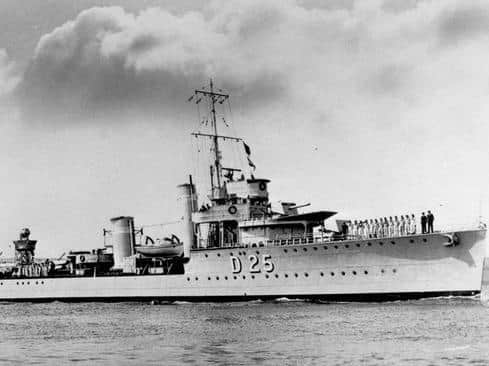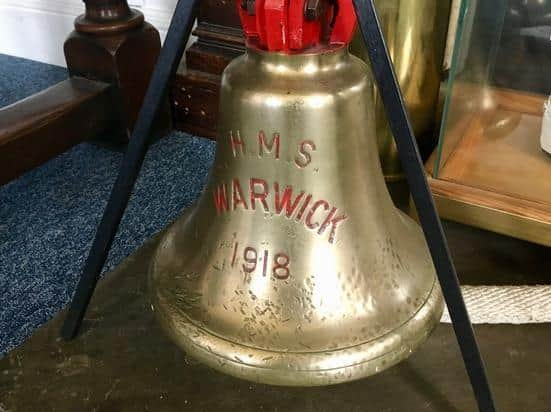The story of HMS Warwick
and live on Freeview channel 276
Exactly 80 years ago, the V&W Class Destroyer HMS Warwick was escorting convoys bringing essential supplies to Britain across the Atlantic, searching for and attacking German U-boats.
HMS Warwick was formally adopted by the town in Warships Week in February 1942, after local people and businesses had raised £280,436 - part of a national campaign to raise funds for the construction of more ships at the height of the Battle of the Atlantic.
Advertisement
Hide AdAdvertisement
Hide AdBut the warship's association with the town stretched back 25 years earlier.


When Bill Forster, historian and publisher of books about the navy in WW2, saw the Courier article about the local men who served in the navy during the war, he got in touch with the Unlocking Warwick volunteers who are researching the stories behind the names on the war memorial in Church Street.
He is an expert in the V&W Class Destroyers; his father served on one during the war.
Bill has supplied more details about the story of HMS Warwick, which was battered by mines and torpedoes in both world wars, but could proudly boast that no merchant ships were lost in the convoys it was protecting.
In the First World War


Advertisement
Hide AdAdvertisement
Hide AdIn the First World War many ships were named after British towns and cities. It was inevitable that Warwick would form close ties with the destroyer that bore its name.
HMS Warwick, was launched on Tyneside by the Countess of Warwick, Daisy Greville, in December 1917, and immediately went into action in the closing months of WW1.
The brand new warship became the flagship of Rear Admiral Sir Roger Keyes when he led the raid on Zeebrugge on St. George's Day 1918, and later he presented the ensign that he flew during the raid to the town of Warwick.
It now hangs in St. Mary's Church along with a wooden plaque.
Advertisement
Hide AdAdvertisement
Hide AdHMS Warwick also took part in a second raid on the German ships harboured on the Belgian coast - at Ostend - and was badly damaged when she struck a mine that broke her back and she had to be towed back to Dover.
After repairs the Warwick was soon back in action and was present at Scapa Flow in November 1918 when the German High Seas Fleet surrendered there at the end of WW1.
A bell from the ship, marked 1918, is on display in the Town Council Chamber in the Court House; it was presented to the town many years later when the ship was formally adopted.
The close ties between the destroyer and the town were demonstrated when the ship was put into the Reserve in 1930.
Advertisement
Hide AdAdvertisement
Hide AdA delegation from Warwick was given a tour of the ship in Plymouth and the Warwick Advertiser reported on a presentation by the Deputy Mayor to the Commanding Officer of a silver replica of the famous Warwick Vase – a large 2nd century Roman marble vase owned by the Earls of Warwick and now in the Burrell Collection near Glasgow.
In return the visitors were presented with a framed photograph of HMS Warwick with the crew formally paraded on deck. It now hangs in St. Mary's Church and a framed copy is in the ante room of the ballroom in the Court House.
Back in Action in WW2
With the onset of WW2 in 1939, HMS Warwick was recommissioned and served as a convoy escort in the Atlantic being too outdated for modern destroyer work.
In December 1940 she was mined for a second time and spent the next four months in dock for repairs before resuming anti-submarine duties in the Western Approaches and the Bay of Biscay.
Advertisement
Hide AdAdvertisement
Hide AdThe formal adoption of the ship by the borough of Warwick in 1942 encouraged local people to send the crew Christmas presents and knitted scarves and gloves, and was marked by a ceremony in the Market Place.
In front of a large crowd, officers presented a plaque with the county coat of arms in gratitude for the raising of over a quarter of a million pounds in Warship Week.
The End for HMS Warwick
On February 20 1944, Warwick's luck ran out.
While patrolling off the north coast of Cornwall, the ship was struck in the stern by an acoustic torpedo, a 'GNAT' fired by U-boat 413 which zeroed in on the noise of her propellors.
She sank in minutes with the loss of 66 members of the crew.
Advertisement
Hide AdAdvertisement
Hide AdThe Mayor, Alderman Ansell, sent a message of regret and sympathy to the Commanding Officer, who had survived.
The white ensign from HMS Warwick hanging in St. Mary's is now dedicated to the memory of those who died serving in the famous destroyer, a veteran of both world wars.
With thanks to Unlocking Warwick and Bill Forster of the V&W Association.
For more information go to: http://vandwdestroyerassociation.org.uk/HMS_Warwick/
For more information about the Unlocking Warwick project go to: www.warwickwarmemorial.org.uk